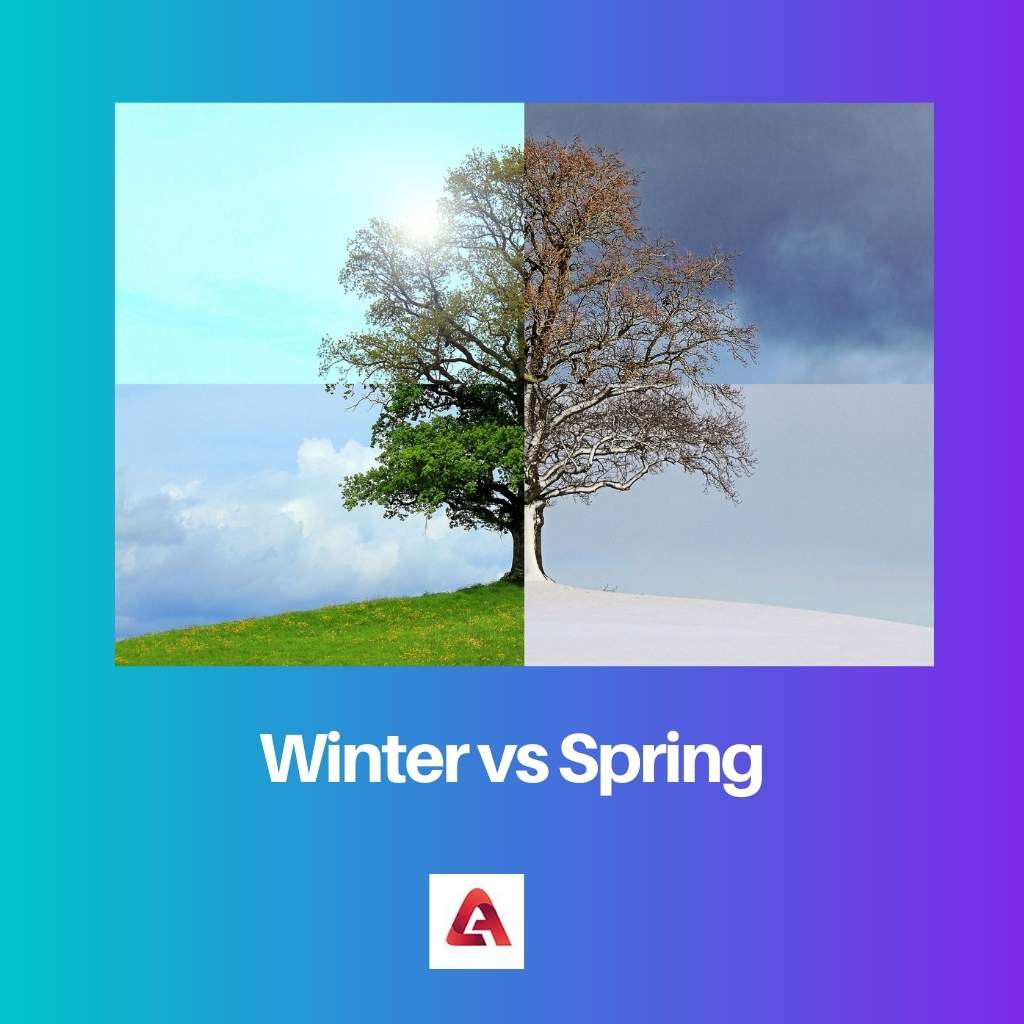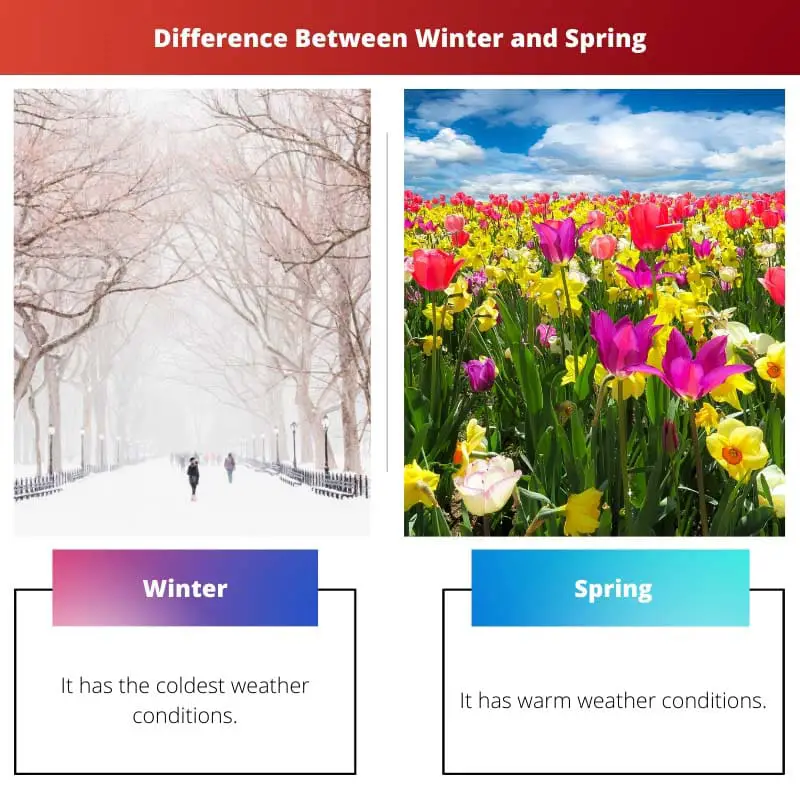Mainly four different seasons result from the earth’s revolution around the sun. The four seasons are Spring, Summer, Autumn, and Winter.
The two seasons, Winter and Spring, do not share many similarities in their main characteristics, weather, and other environmental conditions.
Key Takeaways
- Winter is a season that occurs between December and February in the Northern Hemisphere.
- Spring is a season that occurs between March and May in the Northern Hemisphere.
- Winter is characterized by cold temperatures, snow, and shorter days, while spring is characterized by warmer temperatures, blooming flowers, and longer days.
Winter vs Spring
Winter is the time of the year where is the temperature drops to the lowest and is freezing everywhere. Winter is also said to be the time of water. Spring is the season that comes between winter and summer. During spring, everything blooms, vegetation begins, and flowers appear.

Winter is the season of the year that has the coldest weather conditions. Winter is mainly experienced in the polar and temperate zones. However, it is not experienced in the tropical zone.
The phenomenon takes place after the autumn season and before the Spring season. In many regions, it is associated with snow.
Spring is the year’s season with warm and bright weather conditions. There are different definitions associated with the term based on the local variations in climate, culture, and customs.
The phenomenon takes place after the winter season and before the summer season. It is also known as springtime.
Comparison Table
| Parameters of Comparison | Winter | Spring |
|---|---|---|
| Order | It is the last season of the year. And it comes after Autumn. | It is the first season of the year. And it comes after winter. |
| Weather | It has the coldest weather conditions. | It has warm weather conditions. |
| Months | It resides between December and February in the northern hemisphere. And between June and August in the southern hemisphere. | It resides between March and May in the northern hemisphere. And between September to November in the southern hemisphere. |
| Day and Night | The days are short and nights are long. | The days are long and the nights are short. |
| Vegetation | Vegetation and crop cultivation does not take place in winter. | Vegetation and crop cultivation mostly appears in the spring. |
| Animal behaviour | Many animals go into hibernation during this season. | Animal behaviour is normal and active in the spring season. |
What is Winter?
The term Winter has been derived from “wentruz,” a Proto-Germanic word which gave rise to the old English word Winter. Winter is the fourth and last season of the month that occurs after the preceding autumn spring.
In a certain hemisphere that orients away from the Sun, causes the occurrence of the Winter season occurs due to the axis of the Earth. The North Temperate Zone experiences winter when the sun is at the tropic of Capricorn.
Several cultures define the winter season’s various start and end dates. However, most of them are based on weather conditions. Winters take place alternatively in the Northern Hemisphere and the Southern Hemisphere.
Winter is the coldest season of the year. In many countries, winter comes along with freezing temperatures and snowfall. People may experience a polar climate too.
Because of the cold climate, there are not many leaves left on the trees. In some areas, even the trees are covered with snow. If snowfalls occur, they might cover everything in the snow and sometimes may take lives.
In winter, the risk of accidents due to snow is high. Animals may go into hibernation, and humans prefer to stay inside to be warm and safe, especially in case of snowstorms.

What is Spring?
The first season of the year that comes after winter and before summer is Spring, which is also called Springtime. The placement of the sun directly overhead at the equator causes the occurrence of Spring.
The spring season has varied climatic conditions, such as dry or wet, monsoonal or cyclonic, and so on.
The Spring season is also associated with the ideas of reincarnation, resurrection, revitalization, and growth. It is said that the season brings new light, a new climate, and new rays of hope.
Springtime also has different local names based on their culture and climate. There are many poems based on spring bringing happiness to the environment as well as the minds of the people.
The vegetation begins during this first season of the year. In the spring season, animals come out of their hibernation period and become more active.
Due to the melting of the snow, there is abundant water in the lakes and rivers. The beauty of the season is also associated with devastation. In several areas, the rainfall is heavy.
There are chances of loss of life and property because of heavy rainfall and floods. In some areas, the extreme weather conditions sometimes cause tornadoes and hailstorms too.

Main Differences Between Winter and Spring
- Winter comes after Autumn and is the rearmost season of the year. Spring is the first season of the year, which comes after Winter.
- Winter has the coldest weather conditions. In contrast, Spring has warm weather conditions.
- December, January, and February are the winter months in the northern hemisphere. And June, July, and August in the southern hemisphere. On the contrary, March, April, and May are the spring months in the northern hemisphere. And September, October, and November in the southern hemisphere.
- Vegetation and crop cultivation activities begin in the spring season and not winter.
- In winter, the nights are long, and the days are short. On the contrary, the days are long in spring, and the nights are short.
- Animal behaviour is normal and active in the spring season. In contrast, winter is the hibernation period for some animals like bears.





